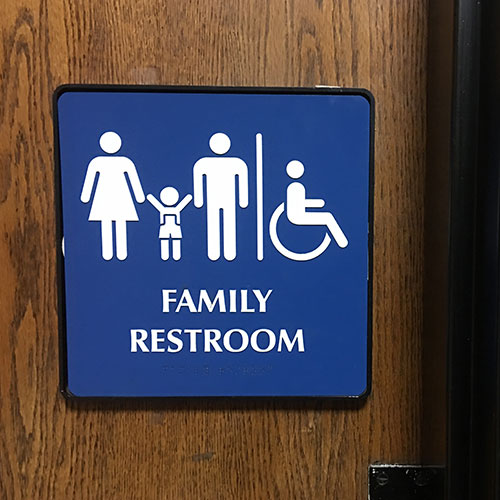
In today’s diverse and inclusive world, ensuring accessibility is a fundamental aspect of building design and public spaces. ADA signs, or Americans with Disabilities Act signs, play a crucial role in this endeavor. For businesses and facilities in Orlando, understanding and implementing ADA signs is not just about compliance; it’s about fostering an inclusive environment that welcomes everyone. This blog explores the importance of ADA signs in Orlando, how they contribute to accessibility, and why they are essential for every public and private space.
Understanding ADA Signs
The Americans with Disabilities Act (ADA) was enacted in 1990 to ensure that people with disabilities have the same rights and opportunities as everyone else. ADA signs are specifically designed to provide clear and accessible information to individuals with disabilities. These signs must meet specific requirements outlined by the ADA to ensure they are effective and compliant. This includes features like braille, high contrast, and easily readable fonts.
Importance of ADA Signs in Orlando
- Compliance with Legal Requirements: In Orlando, as in the rest of the United States, businesses and public facilities are required by law to comply with ADA standards. This means that installing ADA signs is not just a matter of best practice but a legal obligation. Non-compliance can result in penalties and legal actions. Ensuring that your business or facility meets these requirements protects you from potential legal issues and demonstrates your commitment to accessibility.
- Enhancing Accessibility: ADA signs are designed to aid individuals with visual impairments, hearing impairments, and mobility challenges. By providing clear information in braille and high-contrast formats, ADA signs help people navigate spaces more effectively. In Orlando, a city known for its vibrant tourism and diverse population, accessibility is especially important. ADA signs ensure that everyone, including tourists with disabilities, can navigate and enjoy your space with ease.
- Improving User Experience: Beyond legal compliance, ADA signs significantly improve the user experience. For people with disabilities, clear and accessible signage can make a huge difference in their ability to navigate a space independently. This positive experience can enhance your business’s reputation and customer satisfaction. In Orlando’s competitive market, offering an accessible environment can set you apart from others and attract a broader audience.
- Promoting Inclusivity: ADA signs are a testament to your commitment to inclusivity and equal access. In a diverse city like Orlando, showcasing your dedication to accommodating all individuals, regardless of their abilities, fosters a positive community image. It sends a strong message that your business or facility values and respects everyone’s needs.
Types of ADA Signs
- Restroom Signs: Clearly marked restrooms with braille and tactile characters are essential in any public space. These signs ensure that individuals with visual impairments can locate and access facilities independently.
- Directional Signs: ADA-compliant directional signs help people navigate complex buildings or large facilities. These signs should include braille and raised text, as well as clear, simple graphics.
- Parking Signs: Accessible parking signs with proper ADA symbols and text are crucial for individuals with mobility challenges. These signs ensure that designated parking spaces are easy to find and use.
- Emergency Exit Signs: ADA-compliant emergency exit signs are vital for safety. They must be easily readable and include braille to help individuals evacuate quickly in case of an emergency.
Implementing ADA Signs in Orlando
When implementing ADA signs in your Orlando business or facility, consider the following steps:
- Consult with Experts: Work with professionals who specialize in ADA signage to ensure compliance with local and federal regulations. They can provide guidance on design, placement, and material requirements.
- Conduct a Site Assessment: Evaluate your space to determine the best locations for ADA signs. Consider high-traffic areas, entrances, exits, and essential facilities.
- Choose Quality Materials: Invest in durable and high-quality materials for your ADA signs. This ensures longevity and legibility, especially in high-use areas.
- Regular Maintenance: Periodically check and maintain your ADA signs to ensure they remain in good condition and continue to meet ADA standards.
Conclusion
ADA signs in Orlando are more than just a regulatory requirement—they are a crucial element of creating an accessible, inclusive environment. By investing in high-quality ADA signage, you not only comply with legal obligations but also enhance the accessibility and user experience for all individuals. Embracing ADA signs demonstrates your commitment to inclusivity and helps your business or facility stand out as a welcoming space for everyone.
MILTON Aqua 500 Stainless Steel Water Bottle, 500 ml water bottles, Single walled, Leak-Proof, Rust-free Steel Bottle, Easy Grip, Easy to Carry, Travel Bottle, Purple
₹277.00 (as of 4 February, 2025 11:29 GMT +05:30 - More infoProduct prices and availability are accurate as of the date/time indicated and are subject to change. Any price and availability information displayed on [relevant Amazon Site(s), as applicable] at the time of purchase will apply to the purchase of this product.)EZILO Fridge Storage Boxes Freezer Storage Containers 6 Grid fridge Storage Box Container for KitchenStorage in Kitchen Vegetable Storage Draining Crisper Refrigerator Food Box
₹250.00 (as of 4 February, 2025 11:32 GMT +05:30 - More infoProduct prices and availability are accurate as of the date/time indicated and are subject to change. Any price and availability information displayed on [relevant Amazon Site(s), as applicable] at the time of purchase will apply to the purchase of this product.)Cookwell Bullet Mixer Grinder (5 Jars, 3 Blades, Silver) - Copper, 600 Watts - 2 Year Warranty
₹2,199.00 (as of 4 February, 2025 11:29 GMT +05:30 - More infoProduct prices and availability are accurate as of the date/time indicated and are subject to change. Any price and availability information displayed on [relevant Amazon Site(s), as applicable] at the time of purchase will apply to the purchase of this product.)Rylan Electric Lighter for Candles Rechargeable Electric Gas Lighter Home Use Candle Lighter Plasma Flameless Windproof USB Lighter 360° Flexible Neck Arc Lighter (Multicolor)
₹249.00 (as of 4 February, 2025 11:32 GMT +05:30 - More infoProduct prices and availability are accurate as of the date/time indicated and are subject to change. Any price and availability information displayed on [relevant Amazon Site(s), as applicable] at the time of purchase will apply to the purchase of this product.)BELOXY USB Plasma Rechargeable Electric Gas Lighter for Kitchen, Pooja Room, Candles, BBQ, Multi Purpose - 360 Degree Flexible & Windproof
₹298.00 (as of 4 February, 2025 11:32 GMT +05:30 - More infoProduct prices and availability are accurate as of the date/time indicated and are subject to change. Any price and availability information displayed on [relevant Amazon Site(s), as applicable] at the time of purchase will apply to the purchase of this product.)Discover more from The General Post
Subscribe to get the latest posts sent to your email.




